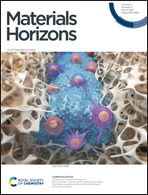Semiconductor to topological insulator transition induced by stress propagation in metal dichalcogenide core–shell lateral heterostructures†
Abstract
Polymorphic phase transitions are an important route for engineering the properties of two-dimensional materials. Heterostructure construction, on the other hand, not only allows the integration of different functionalities for device applications, but also enables the exploration of new physics arising from proximity coupling. Yet, implementing a design that incorporates the advantages of both remains underexplored. Here, based on comprehensive experimental and theoretical studies of the WSe2/SnSe2 core–shell lateral heterostructure, we demonstrate an unexpected H to T′ phase transition in transition metal dichalcogenides (TMDs), correlating with a change of the material properties from a semiconductor to a topological insulator (TI), and propose a novel shell-to-core stress propagation mechanism. This finding offers new insights into TMD phase transitions empowered by the rational design of heterostructures. Owing to the superconducting properties of SnSe2 at low temperatures, the unique TI/superconductor core–shell template is expected to add to the arsenal in the ongoing search for Majorana fermions in condensed matter systems.



 Please wait while we load your content...
Please wait while we load your content...